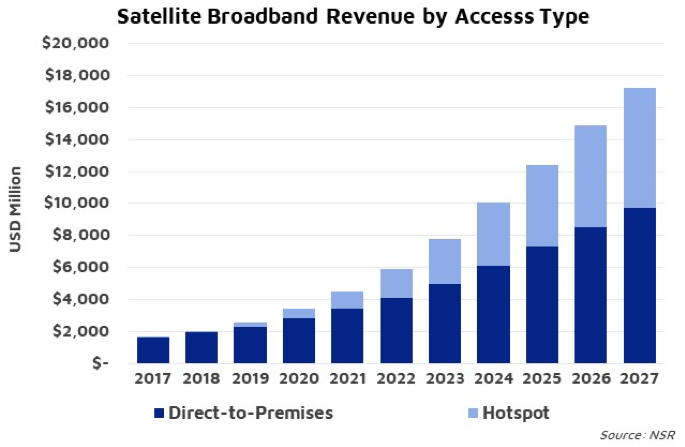Will Satellite Operators Become (Rural) Mobile Operators?
Connecting the “other 3 billion” is a recurring motto for the satcom Industry. Unfortunately, the reality is that the impact on mitigating the digital divide is still modest. Mobile is the de facto way of getting online for “the bottom of the pyramid” but here, satellite can still find enormous opportunities by complementing the gaps of terrestrial networks. Given this trend, are Wi-Fi hotspots over satellite the key way for satcom to bring the unconnected online?

Numerous actors in the satcom space are launching Wi-Fi hotspot offers to serve the low-end segments of the market. The addressable market for these kinds of solutions is massive given the billions living in underserved areas. According to NSR’s VSAT and Broadband Markets, 17th Edition report, Wi-Fi hotspot annual service revenues will reach $7.5 billion by 2027, representing 43% of total satellite consumer broadband revenues. How should business models adapt to this emerging business case?
Connecting the Unconnected
The different pieces of the puzzle seem to be aligning for the satellite industry to articulate a meaningful offer to bring the low-end segments of the market online:
- Affordability. The industry has made tremendous progress in its competitiveness in terms of price per GB. With HTS becoming the norm, satellite broadband offers can now meet UN Broadband Commission affordability targets of 1 GB of data for less than 2% of the monthly GNI per capita unlocking solid elasticities.
- Equipment. Terminals were historically another major barrier, but performances expanded well while keeping prices very competitive. Today, a satellite terminal that supports double-digit Mbps with 10s of concurrent sessions combined with a Wi-Fi smallcell is below the $1,000 USD threshold, which is within the reach of local businesses.
- Distribution Channels. If satcom wants to attract end-users, it needs to get rid of the old ‘build it and they will come’ mindset. It needs a strong commitment to develop efficient retail operations to reach customers. This is progressively changing with more and more actors introducing last-mile activities in their strategic thinking.
Mind the Ecosystem
For the model to succeed, it needs to consider the wider ecosystem. Available income continues to be a challenge, and entry-level packages with small allowances, sometimes as small as 50 MB, are necessary. Some like Quika are even pushing for freemium models with an option to upgrade to add-free and higher-allowance plans.
Another major barrier to consider are digital skills. The customer in rural areas might not have the device or the ability to connect to the Internet, which slows service take up. ViaSat is mitigating this by offering telephony services in its Wi-Fi hotspot with a ViaSat-provided cordless analog telephone. Similarly, many might not feel the need to get online due to lack of relevant content. Offering free access to content like Wikipedia (Afrique Telecom, Wikimedia and Eutelsat partner to offer free access to Wikipedia hosted in local hotspots) can both help distribute educative content and stimulate demand. Additional services such as microfinancing, mobile banking or telemedicine could be other meaningful add-ons.
Building a Sustainable and Scalable Business Model
Despite the tremendous addressable market, the model presents certain challenges in terms of sustainability and scalability. Selecting the right locations to set up the Wi-Fi hotspot is not trivial. It needs a reliable local microentrepreneur with appropriate technical skills to maintain the equipment and run the network. The village must be big enough with adequate disposable income to generate demand but not too large that it will shortly be targeted by terrestrial alternatives. In the same line, the hotspot should be far enough from terrestrial alternatives to avoid being cannibalized by terrestrial solutions, but penetration of mobile devices is crucial to ensure customers can access the network. All these factors must be weighed in when planning to replicate the model beyond pilot installs.
Logistics can also be a nightmare. From shipping a terminal to a remote location probably with limited transport options, to getting a skilled installer or even securing a source of electric power can be serious challenges. Every detail in the model, like returning the cash collected by the microentrepreneurs running the hotspots, need to be planned carefully.
Bottom Line
Billions of people continue living outside any broadband coverage, and satcom can capture a sizable opportunity in closing the digital divide. New business models like Wi-Fi hotspots seem a perfect match between the capacity of satellite to connect remote locations and the ease of access offered by Mobile platforms.
Various elements in the satellite industry are aligning to unlock the opportunities in underserved areas as well as the lower income segments of the market. Cheaper capacity prices, powerful terminals and a greater focus on retail channels will transform Wi-Fi hotspots into a key driver for satcom growth.
Although opportunities abound, the model is not free from challenges. Building the right ecosystem to stimulate demand among end-users is not straightforward. Similarly, any actor willing to invest in this use case must carefully plan its operations to scale the business sustainably.
NSR supports equipment vendors, service providers, satellite operators, end-users and financial institutions in their technology and business strategy assessment and planning.
Please contact info@nsr.com for more information.
